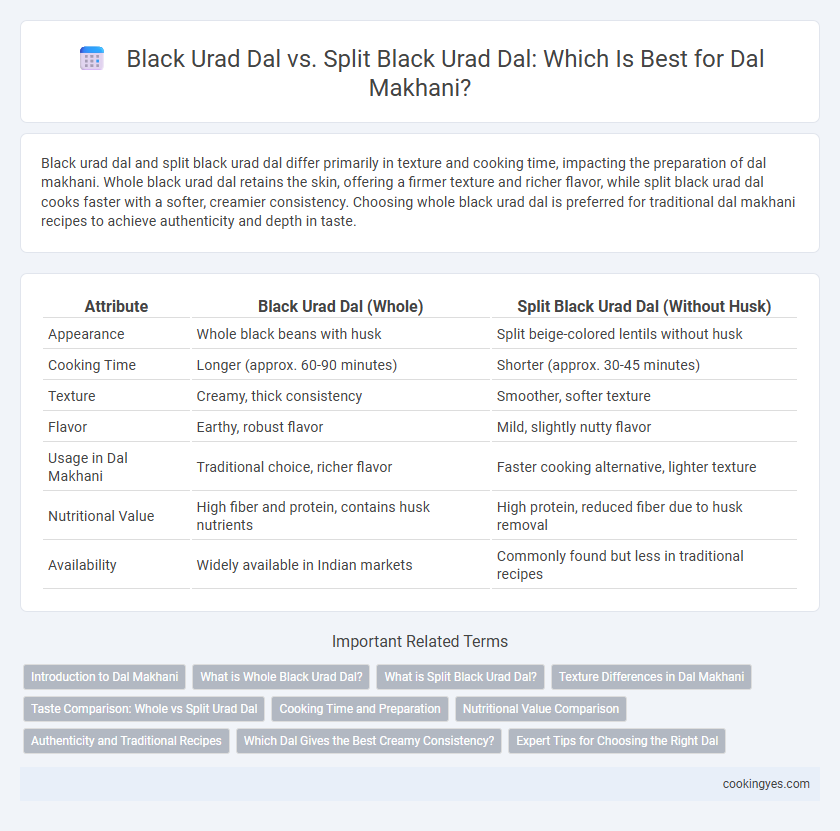Black urad dal and split black urad dal differ primarily in texture and cooking time, impacting the preparation of dal makhani. Whole black urad dal retains the skin, offering a firmer texture and richer flavor, while split black urad dal cooks faster with a softer, creamier consistency. Choosing whole black urad dal is preferred for traditional dal makhani recipes to achieve authenticity and depth in taste.
Table of Comparison
| Attribute | Black Urad Dal (Whole) | Split Black Urad Dal (Without Husk) |
|---|---|---|
| Appearance | Whole black beans with husk | Split beige-colored lentils without husk |
| Cooking Time | Longer (approx. 60-90 minutes) | Shorter (approx. 30-45 minutes) |
| Texture | Creamy, thick consistency | Smoother, softer texture |
| Flavor | Earthy, robust flavor | Mild, slightly nutty flavor |
| Usage in Dal Makhani | Traditional choice, richer flavor | Faster cooking alternative, lighter texture |
| Nutritional Value | High fiber and protein, contains husk nutrients | High protein, reduced fiber due to husk removal |
| Availability | Widely available in Indian markets | Commonly found but less in traditional recipes |
Introduction to Dal Makhani
Dal Makhani, a traditional Punjabi dish, is made using Black urad dal or Split black urad dal, both prized for their rich texture and earthy flavor. Whole Black urad dal offers a creamier consistency and slower cooking time, enhancing the dish's depth, while Split black urad dal cooks faster and absorbs spices more readily, making it ideal for quicker preparations. The choice between these dals influences the authenticity and final taste profile, with whole Black urad dal preferred for its velvety richness in classic Dal Makhani recipes.
What is Whole Black Urad Dal?
Whole Black Urad Dal refers to un-split black gram beans that retain their outer black skin and offer a rich, creamy texture when cooked. It is favored for Dal Makhani due to its ability to absorb flavors deeply, providing a robust, earthy taste and a velvety consistency. Using whole black urad dal ensures a traditional, authentic Dal Makhani experience compared to split black urad dal, which has a lighter texture and quicker cooking time.
What is Split Black Urad Dal?
Split black urad dal, also known as split black gram, is black urad dal with its outer black skin removed, revealing a creamy white interior. This version cooks faster and is preferred in dal makhani for its smooth, creamy texture and quicker absorption of spices. The whole black urad dal offers a nuttier flavor and firmer texture, but split black urad dal ensures a richer, creamier consistency in the final dish.
Texture Differences in Dal Makhani
Black urad dal, whole and un-split, offers a creamier and richer texture in dal makhani due to its intact skin and higher starch content, resulting in a silky, smooth consistency. Split black urad dal, with the skins removed and split, tends to cook faster but produces a lighter, less creamy texture, making the dal slightly grainier and less velvety. The choice between whole and split black urad dal significantly influences the traditional creamy mouthfeel that defines authentic dal makhani.
Taste Comparison: Whole vs Split Urad Dal
Whole black urad dal offers a rich, earthy flavor and a creamy texture that is essential for authentic dal makhani, enhancing its depth and smoothness. Split black urad dal, while quicker to cook and slightly milder in taste, results in a lighter texture but lacks the robust, velvety finish of the whole variety. The choice between whole and split urad dal directly affects the traditional taste profile and mouthfeel of dal makhani.
Cooking Time and Preparation
Black urad dal retains its whole skin, requiring longer soaking and cooking times of up to 2 hours to achieve the creamy texture essential for dal makhani. Split black urad dal, with its outer husk removed, significantly reduces cooking time to about 30-40 minutes and requires minimal soaking, making it a convenient choice for faster preparation. Both types enhance dal makhani's richness, but split dal offers efficiency without compromising the dish's classic taste.
Nutritional Value Comparison
Black urad dal retains its whole seed structure, offering higher fiber content and essential minerals like iron and magnesium compared to split black urad dal, which has the husk removed. The split variety cooks faster but has slightly reduced dietary fiber and mineral content due to processing. Both types provide substantial protein and are rich in complex carbohydrates, making them valuable for dal makhani's nutritional profile.
Authenticity and Traditional Recipes
Black urad dal retains its whole seed, offering a creamier texture and richer flavor essential for authentic dal makhani, while split black urad dal cooks faster but lacks the depth traditional recipes demand. Traditional dal makhani relies on the intact black urad dal to achieve the characteristic slow-cooked, buttery consistency and robust taste central to Punjabi cuisine. Using whole black urad dal preserves the integrity and aroma crucial for delivering the genuine culinary experience of classic dal makhani.
Which Dal Gives the Best Creamy Consistency?
Whole black urad dal offers the creamiest consistency for dal makhani due to its intact outer skin and natural moisture-retaining properties. Split black urad dal, having the husk removed, tends to cook faster but results in a less creamy and slightly grainy texture. For rich, velvety dal makhani, whole black urad dal is the preferred choice among chefs and home cooks.
Expert Tips for Choosing the Right Dal
Whole black urad dal retains its natural outer skin, offering a creamier texture and richer flavor ideal for authentic Dal Makhani. Split black urad dal cooks faster and absorbs spices quickly but lacks the depth and creaminess found in whole urad dal. Expert cooks recommend using whole black urad dal soaked overnight to achieve the perfect balance of texture, taste, and consistency in traditional Dal Makhani recipes.
Black urad dal vs Split black urad dal for dal makhani Infographic

 cookingyes.com
cookingyes.com